The wildlife of the Tambopata National Reserve is incredibly diverse and fascinating. On this photographic journey through the Peruvian Amazon, we can spot jaguars, giant otters, macaws, and many other exotic species. Tambopata is home to over 632 bird species, 169 mammals, and dozens of reptiles and amphibians. Tours organized by specialized agencies take you to the best observation spots, where you can photograph jungle landscapes and wildlife in their natural habitat.
How to Get to the Tambopata National Reserve
The usual starting point is Puerto Maldonado, in Madre de Dios. From Lima or Cusco, there are daily flights (approximately 1h 40min) to Puerto Maldonado. You can also take an overnight bus from Cusco (around 10h). Once in Puerto Maldonado, there is a short land transfer to the Madre de Dios or Tambopata River, followed by a 2 to 3-hour boat ride to the lodges inside the reserve.
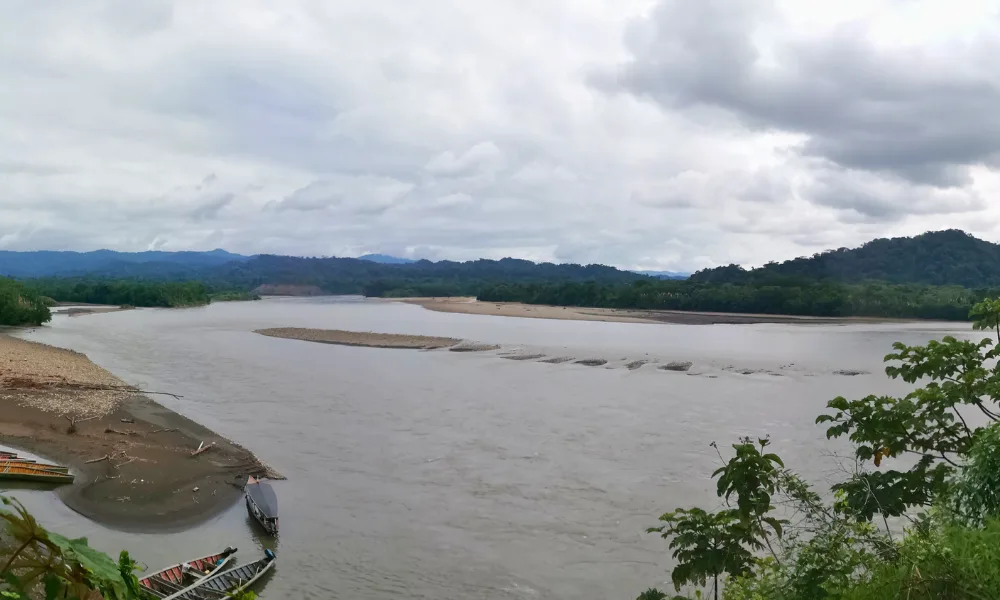
Wildlife of the Tambopata National Reserve: Species to Photograph in the Jungle
Tambopata’s incredible biodiversity allows you to see many species in a single trip. In its rivers, forests, and swamps live jaguars, pumas, howler monkeys, and giant otters. There are also brightly colored macaws, harpy eagles, and the unusual hoatzin. With more than 270,000 protected hectares, Tambopata offers misty sunrises over the river, flocks of parrots and macaws at the clay licks, and night walks with glowing frogs. All of this makes the wildlife of the Tambopata National Reserve a paradise for wildlife photographers.
Mammals of the Tambopata National Reserve
The wildlife of the Tambopata National Reserve includes about 169 species of mammals. Among the most sought-after for photography are the jaguar (Panthera onca), the puma, the giant anteater, and the South American tapir, the largest land mammal in South America. In the rivers live the giant otter (Pteronura brasiliensis) and the neotropical otter (Lontra longicaudis). Other notable mammals are howler monkeys and woolly monkeys.
- Jaguar (Panthera onca)
- South American tapir (Tapirus terrestris, “sachavaca”)
- Giant anteater (Myrmecophaga tridactyla)
- Giant otter (Pteronura brasiliensis)
- Howler monkey (Alouatta seniculus)
- Neotropical otter (Lontra longicaudis)
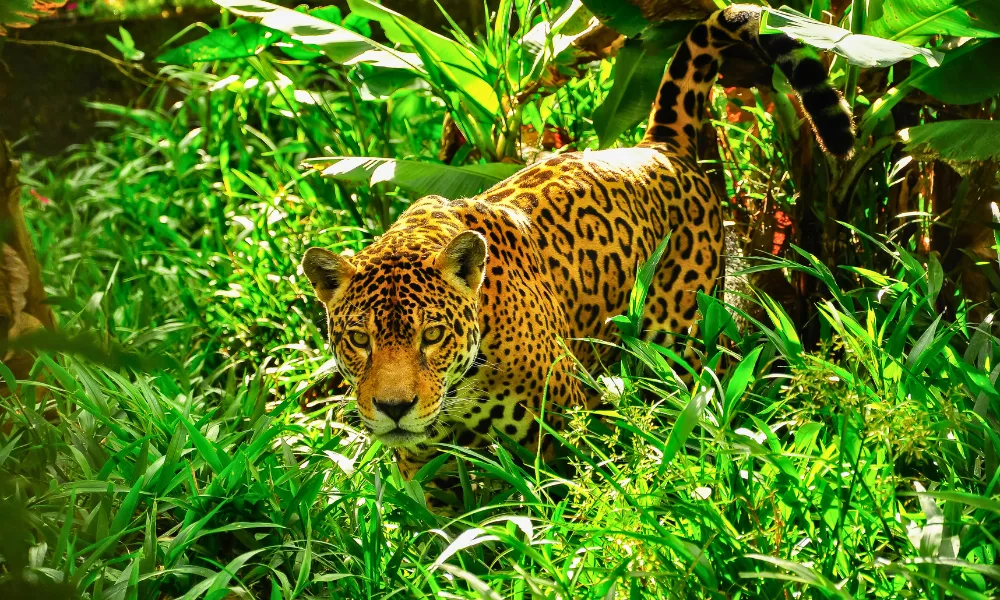
Birds of the Tambopata National Reserve
Tambopata is home to over 600 bird species. The colorful macaws stand out, nesting and feeding on the clay cliffs known as collpas. There are eight distinct species, such as the scarlet macaw and the blue-and-yellow macaw. You can also photograph the impressive harpy eagle (the largest bird of prey in the Americas) and the curious hoatzin. In addition, you may see toucans, Amazonian kingfishers, parrots, and other exotic birds.
- Macaws (scarlet, blue-and-yellow)
- Harpy eagle (Harpia harpyja)
- Amazonian hoatzin (Opisthocomus hoazin)
- Keel-billed toucan (Ramphastos sulfuratus)
- Amazonian kingfisher
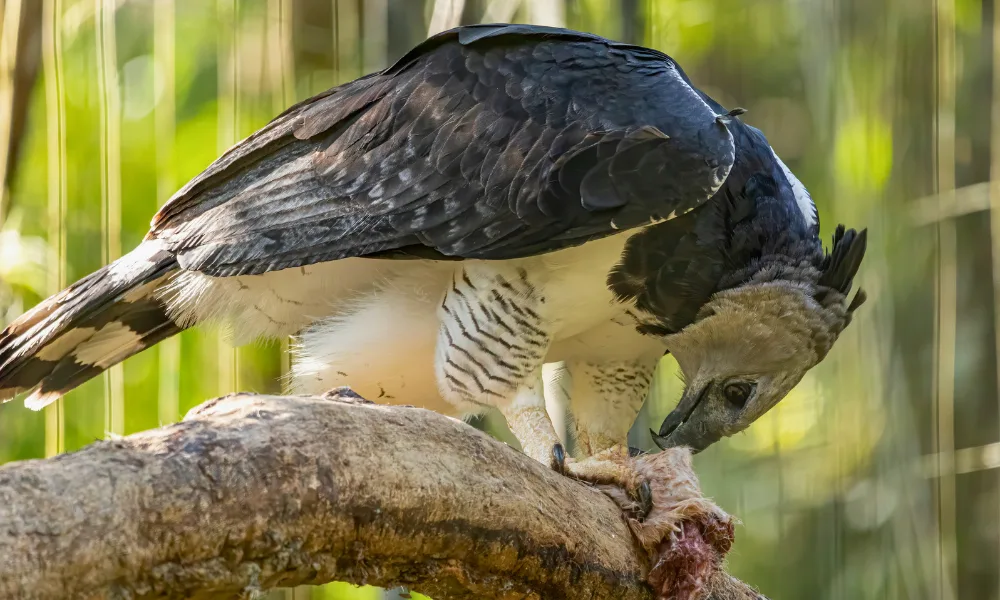
Reptiles of the Tambopata National Reserve
The wildlife includes over 100 reptile species. Among the most sought-after are the boa constrictor and the emerald tree boa. The area is also home to anacondas, lizards, iguanas, and venomous snakes such as the bushmaster (Lachesis muta). In the rivers lives the black caiman (the largest in the Americas), and on the sandy beaches, turtles such as the taricaya come to nest.
- Green anaconda (Eunectes murinus)
- Emerald tree boa (Corallus caninus)
- Boa constrictor
- Black caiman (Melanosuchus niger)
- Taricaya turtle (Podocnemis unifilis)
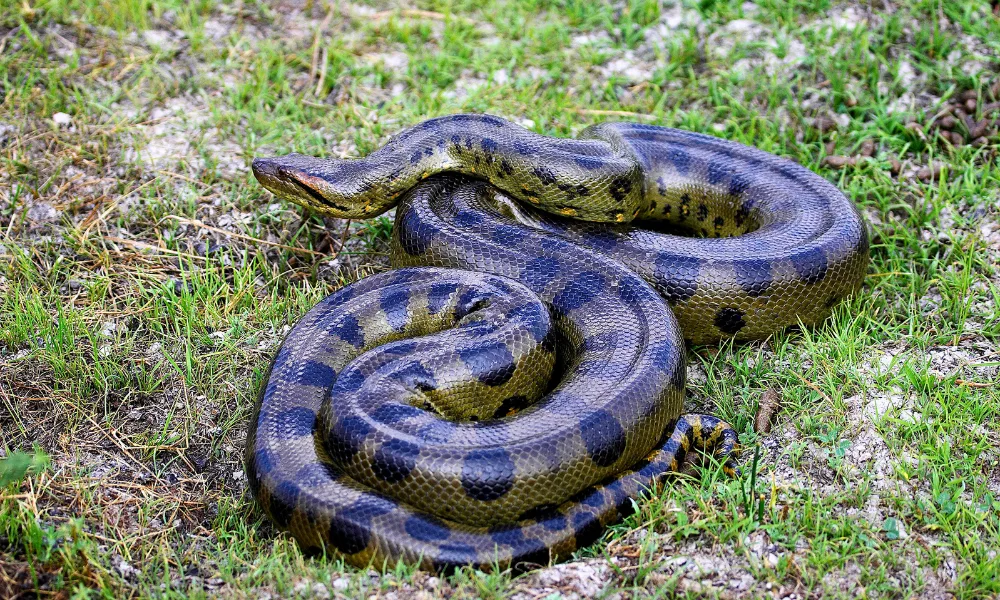
Amphibians of the Tambopata National Reserve
Tambopata has over 100 amphibian species. The poison dart frogs stand out, famous for their bright colors and potent toxins. You can also find the giant marine toad (Rhinella marina) and the horned frog (Ceratophrys cornuta). In the treetops, you can see red-eyed tree frogs and other unique species of the Amazonian swamps.
- Poison dart frog (Dendrobatidae)
- Horned frog (Ceratophrys cornuta)
- Giant marine toad (Rhinella marina)
- Red-eyed tree frog (Agalychnis sp.)
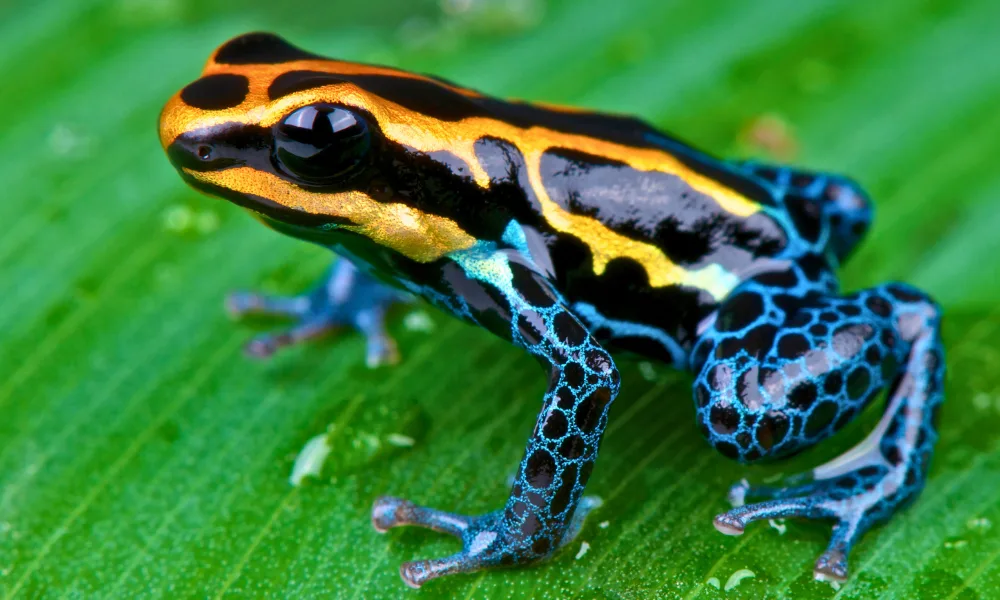
Wildlife Watching and Photography Experience in Tambopata
Traveling to Tambopata means immersing yourself in an incredible natural world. Local guides from Travel Peru Agency organize sunrise and sunset outings to observe wildlife. During these excursions, you visit the macaw clay licks, riverbanks, and riparian forests. On special nights, night walks are also arranged to look for frogs and reptiles. The entire tour is conducted in compliance with ecological guidelines.
Best Places for Wildlife Watching
- Macaw clay licks: Salty clay cliffs where hundreds of macaws and parrots gather at sunrise. The Chuncho and Tres Chimbadas clay licks stand out for their striking bird concentrations, where intense reds, blues, and yellows contrast with the deep green of the jungle.
- Tambopata River banks: Beaches and shores where you can see giant otters, caimans, turtles, and waterbirds. Boating at sunrise or sunset offers unique panoramic shots.
- Terra firme forests and palm swamps: Trails where monkeys, ocelots, tapirs, and a great variety of birds live.
Tips for Photographing Wildlife in Tambopata
- Photography gear: DSLR or mirrorless camera with good ISO performance, long telephoto lens (200–600 mm), wide-angle lens, lightweight tripod or monopod. Bring extra batteries, memory cards, and moisture protection.
- Photography techniques: Golden light at sunrise/sunset, fast shutter speeds for birds and monkeys, burst shooting, and wide apertures for blurred backgrounds.
- Ethics and respect: Keep a safe distance, avoid direct flash, do not feed animals, and work with professional guides.

Best Time to Visit the Tambopata National Reserve
The dry season (May to October) is the best for wildlife watching and photography. There’s less rain, clear skies, and accessible trails. Animals gather around water sources, increasing the chances of sightings. From June to September, clay lick activity is higher and there are more sunny days. During the rainy season (December to March), the jungle is denser and trails can flood.
Frequently Asked Questions about the wildlife of the Tambopata National Reserve
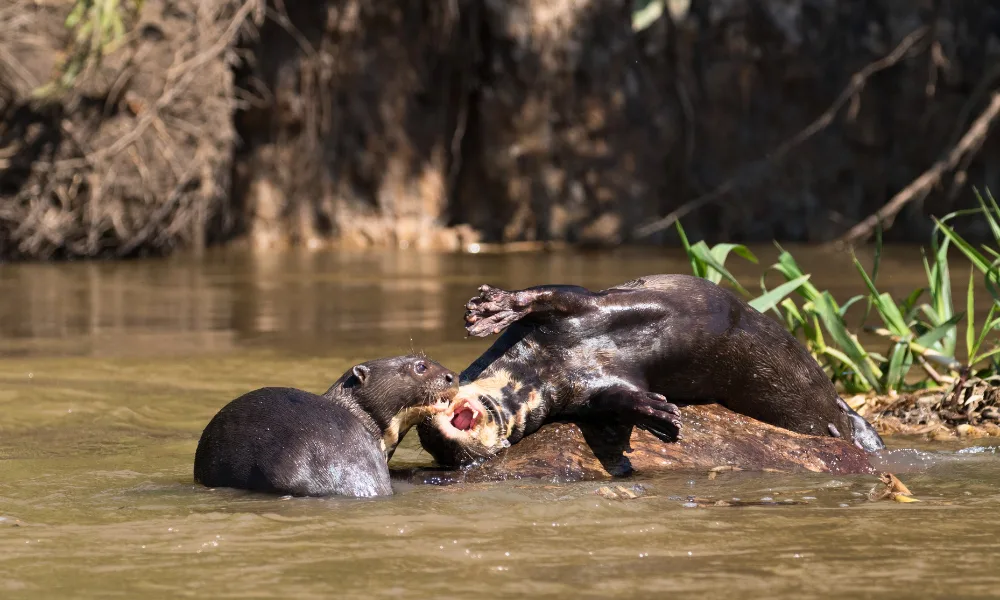
1. What iconic animals can I photograph in Tambopata?
The wildlife of the Tambopata National Reserve includes iconic species such as the giant otter (Pteronura brasiliensis), the jaguar, and the puma. Among the birds, the colorful macaws, harpy eagle, and hoatzin stand out. The region is also home to unique reptiles and amphibians, such as poison dart frogs and the impressive green anaconda.
2. Where are the clay licks in Tambopata and why are they special?
The clay licks are clay cliffs located along rivers, where parrots and macaws gather at sunrise to ingest essential minerals. In Tambopata, the Chuncho, Tres Chimbadas, and Tambopata Research Center clay licks offer a unique natural spectacle, with hundreds of macaws flying and perching in a vibrant display of colors.
3. What is the best time of day to photograph wildlife in the Tambopata National Reserve?
The early morning and late afternoon are the most recommended times. At sunrise and sunset, the soft golden light creates perfect conditions for photography, and wildlife is usually more active. In the morning, it is common to see birds sunbathing or feeding at the clay licks, while at night flashlight excursions are conducted to observe reptiles and amphibians.
4. How can I book a wildlife photography tour in the Tambopata National Reserve?
There are specialized agencies offering wildlife watching tours in Tambopata, with eco-friendly packages lasting 2 to 4 days that include transfers from Cusco or Puerto Maldonado, lodge accommodation, and experienced local guides. These tours visit the best spots in the Reserve for nature photography, always following responsible tourism practices.
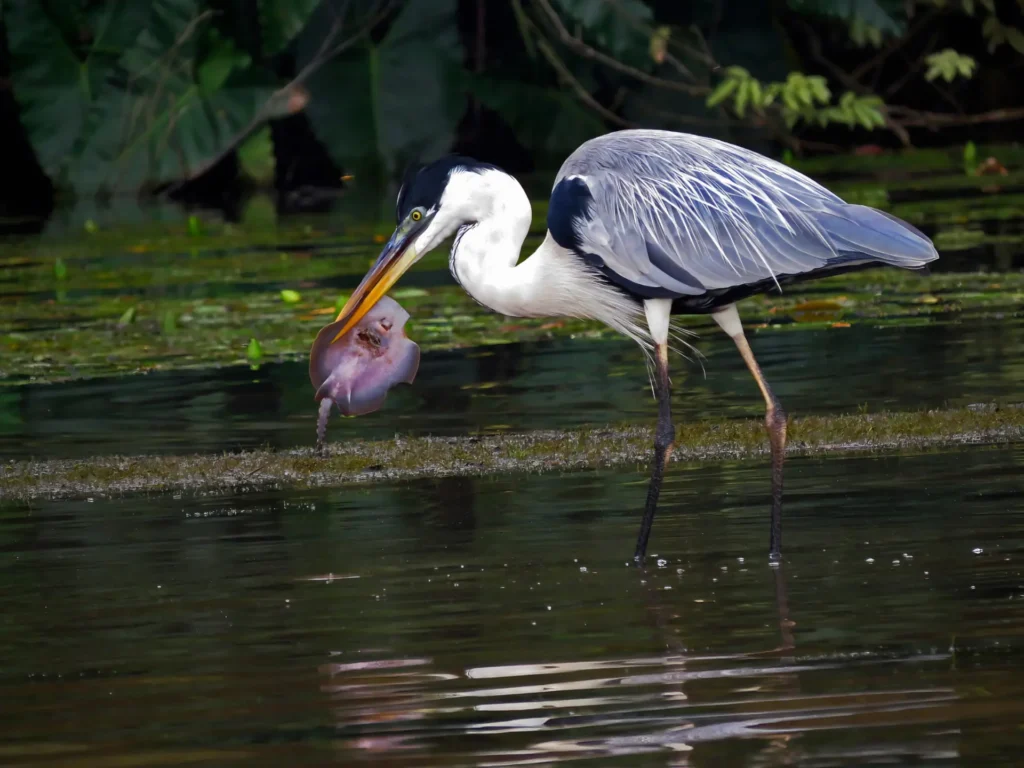
The wildlife of the Tambopata National Reserve is incredibly diverse, with 632 bird species, 169 mammals, and numerous reptile and amphibian species. You can observe jaguars, giant otters, macaws, and harpy eagles at clay licks, rivers, and forests. With 270,000 protected hectares, it is a paradise for nature photography, through guided tours that promote conservation. Contact us and book your trip to the Tambopata National Reserve.